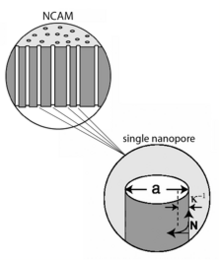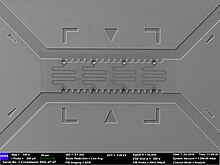Nanofluidics

Nanofluidics is the study of the behavior, manipulation, and control of
When structures approach the size regime corresponding to molecular scaling lengths, new physical constraints are placed on the behavior of the fluid. For example, these physical constraints induce regions of the fluid to exhibit new properties not observed in bulk, e.g. vastly increased
All electrified interfaces induce an organized charge distribution near the surface known as the
Theory
In 1965, Rice and Whitehead published the seminal contribution to the theory of the transport of electrolyte solutions in long (ideally infinite) nanometer-diameter capillaries.[1] Briefly, the
where κ is the inverse Debye length,
determined by the ion
where η is the viscosity, dp/dz is the pressure gradient, and Fz is the body force driven by the action of the applied electric field, Ez, on the net charge density in the double layer. When there is no applied pressure, the radial distribution of the velocity is given by,
From the equation above, it follows that fluid flow in nanocapillaries is governed by the κa product, that is, the relative sizes of the Debye length and the pore radius. By adjusting these two parameters and the surface charge density of the nanopores, fluid flow can be manipulated as desired.
Fabrication

Nanostructures can be fabricated as single cylindrical channels, nanoslits, or nanochannel arrays from materials such as silicon, glass, polymers (e.g. PMMA, PDMS, PCTE) and synthetic vesicles.[3] Standard photolithography, bulk or surface micromachining, replication techniques (embossing, printing, casting and injection molding), and nuclear track or chemical etching,[4][5][6][7][8] are commonly used to fabricate structures which exhibit characteristic nanofluidic behavior.
Applications
Because of the small size of the fluidic conduits, nanofluidic structures are naturally applied in situations demanding that samples be handled in exceedingly small quantities, including Coulter counting,[9] analytical separations and determinations of biomolecules, such as proteins and DNA,[2][10] and facile handling of mass-limited samples. One of the more promising areas of nanofluidics is its potential for integration into microfluidic systems, i.e. micrototal analytical systems or lab-on-a-chip structures. For instance, NCAMs, when incorporated into microfluidic devices, can reproducibly perform digital switching, allowing transfer of fluid from one microfluidic channel to another,[11][12] selectivity separate and transfer analytes by size and mass,[11][13][14][15][16] mix reactants efficiently,[17] and separate fluids with disparate characteristics.[11][18] In addition, there is a natural analogy between the fluid handling capabilities of nanofluidic structures and the ability of electronic components to control the flow of electrons and holes. This analogy has been used to realize active electronic functions such as rectification[19][20] and field-effect[21][22][23] and bipolar transistor[24][25] action with ionic currents. Application of nanofluidics is also to nano-optics for producing tuneable microlens array[26][27]
Nanofluidics have had a significant impact in biotechnology, medicine and clinical diagnostics with the development of lab-on-a-chip devices for PCR and related techniques.[28][29] Attempts have been made to understand the behaviour of flowfields around nanoparticles in terms of fluid forces as a function of Reynolds and Knudsen number using computational fluid dynamics.[30][31][32] The relationship between lift, drag and Reynolds number has been shown to differ dramatically at the nanoscale compared with macroscale fluid dynamics.
Challenges
There are a variety of challenges associated with the flow of liquids through carbon nanotubes and nanopipes. A common occurrence is channel blocking due to large macromolecules in the liquid. Also, any insoluble debris in the liquid can easily clog the tube. A solution for this researchers are hoping to find is a low friction coating or channel materials that help reduce the blocking of the tubes. Also, large polymers, including biologically relevant molecules such as DNA, often fold in vivo, causing blockages. Typical DNA molecules from a virus have lengths of approx. 100–200 kilobases and will form a random coil of the radius some 700 nm in aqueous solution at 20%. This is also several times greater than the pore diameter of even large carbon pipes and two orders of magnitude the diameter of a single walled carbon nanotube.
See also
References
- .
- ^ PMID 31290915.
- PMID 15117264.
- ISBN 3-527-30746-X.
- PMID 15856084.
- S2CID 55086101.
- S2CID 201846195.
- S2CID 202869692.
- .
- .
- ^ PMID 12918959.
- S2CID 206065831.
- .
- S2CID 28856045.
- PMID 21662836.
- .
- PMID 15054797.
- PMID 16201814.
- PMID 16542096.
- PMID 22009038.
- .
- PMID 15884899.
- PMID 23915526.
- .
- PMID 17311462.
- PMID 18545521.
- .
- ISBN 978-1-904455-47-9.
- S2CID 125299766.
- hdl:2027.42/69830.
- .
- ISSN 0021-9991.




![{\displaystyle v_{z}\left(r\right)={\frac {\epsilon \phi _{0}}{4\pi \eta }}E_{z}\left[1-{\frac {I_{0}\left(\kappa r\right)}{I_{0}\left(\kappa a\right)}}\right].}](https://wikimedia.org/api/rest_v1/media/math/render/svg/04eb124b1fab0148b6bad2701849be8cf3ffcf7e)